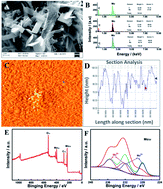An electrochemical sensor based on the composite of molybdenum carbides and a multiwalled carbon nanotube modified electrode for the ultrasensitive detection of rifampicin
Abstract
The composite of molybdenum carbides and multiwalled carbon nanotube (MWCNTs–Mo2C) modified glassy carbon electrode (GCE) was developed to prepare an electrochemical sensor for the ultrasensitive detection of rifampicin. Solvothermal and annealing methods were used to synthesize the MWCNTs–Mo2C composite. The morphology and size of the synthesized materials were characterized using a scanning electron microscope and atomic force microscope. The MWCNTs–Mo2C composite shows a large effective surface area and reveals high electron transfer rate, indicating its excellent electrocatalytic activity. Under optimal conditions, the modified electrode used to analyze rifampicin shows an excellent linear relationship between the peak current and the rifampicin concentration in the range from 0.5 to 74 μM. The limit of detection was 0.045 μM (S/N = 3). The sensor was successfully applied to actual drugs and human serum testing with satisfactory results.



 Please wait while we load your content...
Please wait while we load your content...